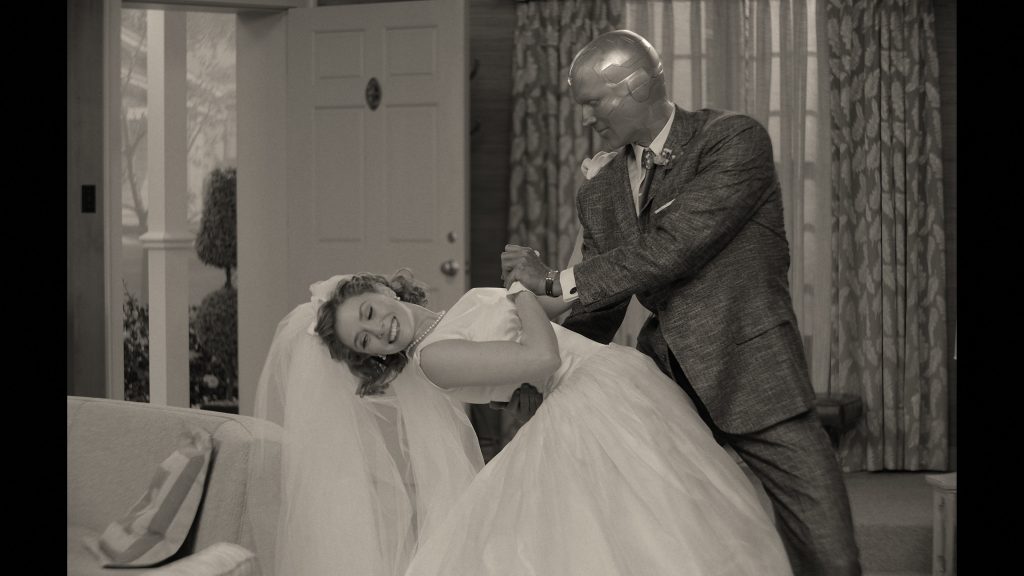
Wanda Maximoff (Elizabeth Olsen) and Vision (Paul Bettany) marry and live a seemingly idyllic suburban life in Marvel’s “WandaVision.” (Marvel Studios)
It’s undeniable that Marvel Studios President Kevin Feige has pulled off a plethora of improbable feats in the last 13 years. Whether it’s turning a talking tree into a pop culture phenomenon or making grown men cry over the death of an armored and pompous superhero, Feige has repeatedly turned lemons into lemonade with his immensely lucrative Marvel Cinematic Universe. With the studio’s first television show, “WandaVision,” Feige attempts what could be his most ambitious feat yet: propelling a generic retro sitcom into the cultural stratosphere with the sole power of the Marvel name. Despite Marvel’s typically stellar track record, the first two episodes of the series, released on Disney+ on Jan. 15, suggest that the studio may finally be primed for failure: “WandaVision” leans too hard into its old-school premise while only briefly hinting at more exciting things to come.
In an era when so much visual media is rebooting the past, several new projects like “Mank,” “Wonder Woman 1984” and now “WandaVision” are literally trying to recreate it. The show’s first two episodes are nearly beat-for-beat recreations of classic mid-20th century sitcoms, complete with cheesy plots and black-and-white aesthetic that could’ve been pulled straight from “I Love Lucy.” The series follows Wanda Maximoff (Elizabeth Olsen) and Vision (Paul Bettany), the superpowered couple Marvel fans last saw together in 2018’s “Avengers: Infinity War,” who are now happily married and settling into a domestic lifestyle in the suburbs. This suburban setting lends itself to the plot of the first two episodes: the pilot revolves around a miscommunication between Wanda and Vision involving dinner guests, and the second episode features them participating in their neighborhood’s annual talent show. However, several strange incidents hint that the reality of the two characters may not be as perfect as it seems.
Merging superhero antics with “The Dick Van Dyke Show” plotlines is an intriguing premise, and director Matt Shakman accurately captures the period’s aesthetic as he transports viewers to a time when plots were simple and laugh tracks reigned supreme. However, the show’s immersiveness is also its greatest flaw, as the episodes thus far do very little to transcend the classic sitcom format. While the show’s old-school vibe may be a refreshing change from the cinematic superhero content studios are throwing at audiences, it’s also not a particularly creative one. Rather than leveraging the tropes of classic sitcoms, Shakman settles for copying them with Marvel superheroes at the forefront. For example, rather than repeatedly joking about the clumsiness or incompetence of the central couple, the show makes myriad jokes about Wanda and Vision trying to hide their superpowers from their neighbors and co-workers.
The show’s immense dedication to accuracy is also problematic when considering that much of the audience is likely tuning in not because they love classic sitcoms, but because of the Marvel Studios brand. While I appreciated the show’s retro aesthetic, it would likely not be as gratifying to those who aren’t familiar with classic sitcoms. About 15 minutes into the first episode, my disgruntled fifteen-year-old brother uttered, “What are they doing with this?” Similar to David Fincher’s “Mank,” “WandaVision” is so dedicated to maintaining its distinct style that it will likely alienate anyone who’s expecting a more traditional superhero show.
This critique does not discount Olsen and Bettany’s performances, who are absolutely delightful and carry the show. Both actors buy into the show’s formula and share a brilliant chemistry as they unveil a new, more human side of their characters. Bettany is hilarious and an absolute joy to watch, especially during his talent show performance in the second episode. Meanwhile, Olsen strikes a masterful balance between enthusiastic housewife and skeptical superhero who gradually realizes the unnatural utopian world around her.
The first two episodes weave in several breadcrumbs that foreshadow future science fiction elements. However, Shakman is rolling out these elements very slowly. With the season almost one-third of the way done (the show will have nine half-hour long episodes), I doubt audiences will have the mileage to endure many more slow-rolling episodes. In fact, if it weren’t for the show’s affiliation with Marvel Studios, I doubt very few would even labor through the first two episodes (and many still may not).
Marvel Studios raked in over $18 billion at the global box office since 2008’s “Iron Man,” and they know that “WandaVision” will have millions of viewers on Disney+ regardless of quality. The first two episodes of the series give me the impression that Feige attempted something different but remained unconcerned that it may not satisfy the fans that rose the studio to prominence in the first place. While two episodes are only a small taste, I’m skeptical fans will endure the rest of the season to see where Shakman and Feige take them. Here’s to hoping Marvel can surprise us yet again.
The post Marvel Trades Ambition for Apathy With ‘WandaVision’ appeared first on The Emory Wheel.
